Now that I’ve shown you a 360-degree view of Alcatraz Island from San Francisco Bay, it’s time to finally set foot on The Rock! In this post, you’ll be following me up the main road to and around the prison, and I’ll be pointing out the buildings and sites as we go.
As an overview of our “tour,” here is an aerial photo from Wikimedia. I have added the locations that you will be seeing along our walk, starting at the dock near the top left.
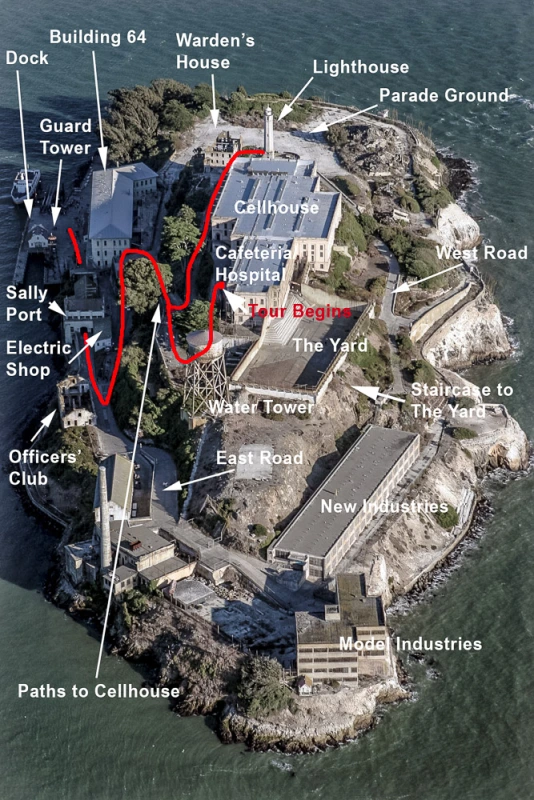 http://www.flickr.com/photos/druchoy/
http://www.flickr.com/photos/druchoy/
Get your walking shoes on, because as you saw from my first post, the island is fairly large, not to mention that the road to the prison is one large incline! Ready? Off we go!
On the Dock
Building 64
Alcatraz was originally a military fort. Spurred by the dramatic increase in San Francisco’s ship traffic and population during the Gold Rush, fortification of the island was part of a three-point defensive strategy for San Francisco Bay. Construction began in 1853 and included bombproof dock-level brick barracks (the lowest of the four levels of the building, below). By the 1890s, advancing military technology made Alcatraz’s fortifications obsolete. The fort was decommissioned, regular army troops were replaced by soldiers of the U.S. Military Guard, and Alcatraz became a military prison. In 1905, three additional stories were added to the dock-level barracks to serve as quarters for soldiers assigned to prison guard duty. The finished building became known as Building 64. When Alcatraz became a federal penitentiary in 1934, the building was remodeled into apartments for correctional officers and their families.
The lighthouse and burned-out shell of the warden’s home are to the left.
The sign reads:
“United States Penitentiary. Alcatraz Island. Area 12 acres. 1-1/2 miles to transport dock. Only government boats permitted. Others must keep off 200 yards. No one allowed ashore without a pass.”
Visitors are required to listen to a short ranger-led introduction to the island before beginning the climb to the prison. I had done my research and quietly moved ahead of the crowd toward the road, hoping to be among the first to get to the cellblock to capture a photo without the crowds.
The Climb Begins
From the dock to the cell house at the top of the island is about 1/4 mile. That’s not far. But (and this is a big “but”), the elevation change is 130 feet, equivalent to a 13-story climb. I was already wearing a knee brace as a result of my walk around San Francisco the prior day. This was going to prove challenging.
Sally Port and Guardhouse
By the time the Civil War broke out in 1861, Alcatraz had 111 cannon, gun emplacements, and a fortified gateway (sally port) protecting the road to the three-story fortification on the island’s summit, “The Citadel.” It was the most heavily fortified military post of its time on the West Coast. The guardhouse could only be reached by an oak drawbridge that spanned a 15-foot-deep dry moat. If attackers made it past the moat, they had to negotiate the sally port, a passageway with heavy iron-studded wooden doors at each end and lines of rifle slits between the two doors.
The sally port was never used to protect the island, and during the Civil War, the gun rooms and basement were converted into prison cells for soldiers convicted of desertion, theft, assault, rape, and murder and for citizens accused of treason. When Alcatraz was designated a military prison in 1907, the guardhouse was completely enclosed. It remains the oldest building on the island (built in 1857).
Post Exchange/Officers’ Club
Built in 1910, the Alcatraz Post Exchange (PX) was the local general store where soldiers and their families could buy food and personal goods. When Alcatraz became a federal prison in 1934, the PX was converted into a recreation hall and officer’s club. It boasted a dance floor, gym, two-lane bowling alley, and soda fountain. It was destroyed by fire in June 1970.
Electric Shop
Looking down from the road’s second switchback to the Dock Tower and an approaching Alcatraz ferry.
Water Tower
Increasing maintenance and operating costs led then-U.S. Attorney General Robert F. Kennedy to close Alcatraz in 1963. It sat dormant until the tail end of the 1960s, when a group of Native American activists landed on the island and claimed it in the name of the “Indians of All Tribes.” The occupiers wanted to focus attention on broken treaties and the closing by the government of Native American reservations. Their intent was to convert the prison buildings into a Native American cultural center and museum. They lived on Alcatraz from November 1969 to June 1971 (19 months), largely without power and running water, until their numbers dwindled to the point where government officials were able to end the occupation. The graffiti on the water tower is one of the few remaining remnants of that time. Painted in red are the words: “Peace and Freedom. Welcome. Home of the Free Indian Land.”
Approaching the Cellhouse Tour Entrance
Continuing on the main road in lieu of proceeding to the tour entrance brings you to the warden’s house and the lighthouse.
Warden’s House
The warden’s house was built in 1926 when Alcatraz was a military prison and served as the residence of the U.S. Army Commandant. It had seventeen large rooms with sweeping views of San Francisco and the bay. Here, you can see a portion of the San Francisco-Oakland Bay Bridge in the distance. The abandoned building was destroyed by fire in 1970.
Lighthouse
On June 1, 1854, in response to the increasing ship traffic of the Gold Rush and because Alcatraz was squarely in line with passage through the Golden Gate, the island became home to the first lighthouse in operation on the Pacific Coast. Today’s 84-foot concrete lighthouse replaced the original in 1909. Keepers lived in a home at its base until 1963, when the lighthouse was automated. The keeper’s quarters was another one of the buildings destroyed by fire in 1970, but the light, operated by the U.S. Coast Guard, continues to provide a beacon to ships in the bay.
Parade Ground
Originally used as a site for military reviews and parades, the Parade Ground was used as a playground and to host special events during the time Alcatraz was a federal prison. As Building 64 began to fall into disrepair, residence housing was built around the perimeter of the ground, along with gardens and handball and weightlifting facilities for the employees and their families. After the prison closed in 1963, these buildings were demolished. Foundation marks are still visible.
Unfortunately, the grounds were closed to visitors on my visit.
Administration Building
Lying behind the lighthouse is the entrance to the prison, where the main administration block of the cellhouse was located. Here was the warden’s office, offices of the associate warden and secretary, mail desk, captain’s desk, a business office, a clerk’s office, an accounting office, a control room, the officer’s lounge, armory and vault, and a visitation center and restrooms.
West Road
Once I recovered from walking the 1/4-mile, 13-story climb to the “top” of the island, I continued past the cellblock entrance and found West Road, a walkway that led me around the western border of the island boasting displays of exotic trees, flowers, and shrubs, as well as spectacular views of the Golden Gate Bridge.
Ornamental gardens
More than 200 species or varieties of plants have been introduced to Alcatraz since the late 1800s. Poppies, roses, nasturtium, fuchsia, pelargonium, and aeonium are just a few that can be found here. Tended to by military officers, wardens, and prisoners, the gardens were carefully cultivated to brighten up the otherwise forlorn setting that was Alcatraz. The gardens were neglected for forty years after the prison’s closure, but today, volunteers from the Garden Conservancy, Golden Gate National Parks Conservancy, and the National Park Service are slowly restoring and reviving the gardens.
Gardens on the western side of the island were tended to by inmate Eliot Michener from 1941-1950, where he created a free-flowing, cottage-garden style, terraced display. He also built the small tool shed on the right. The Garden Conservancy’s project manager for the restoration designed the restored garden, using annuals mixed with perennials that closely represent those Michener chose more than 60 years ago.
Recreation Yard
At the end of the walkway is a sign pointing the way to a very steep staircase that leads to an entrance to the prison’s recreation yard.
Though not the best picture as I caught too much sun flare, I wanted to include it to give you some idea of what the yard looked like. You can see two people hanging off the exterior of what is the hospital and cafeteria wing of the prison (I have no idea what they were doing there). And if you look for the people walking down the steps just to the right, you will see a doorway at the top of those steps – this leads directly into the cellblock and was the door used by the inmates to get into the yard.
Model Industries Building
The Model Industries Building lies at the end of East Road on the northwest corner of the island. Here, prisoners worked to earn money. It housed a laundry room, reportedly the largest on the west coast, providing laundry services to all military bases in the San Francisco Bay area. The top floor was a workshop where prisoners operated a furniture and refinishing plant. The building was later replaced with the New Industries Building, which lies just to its left.
So, are you tired yet? I hope not, because there is so much more to go!
Next post: The Cellhouse

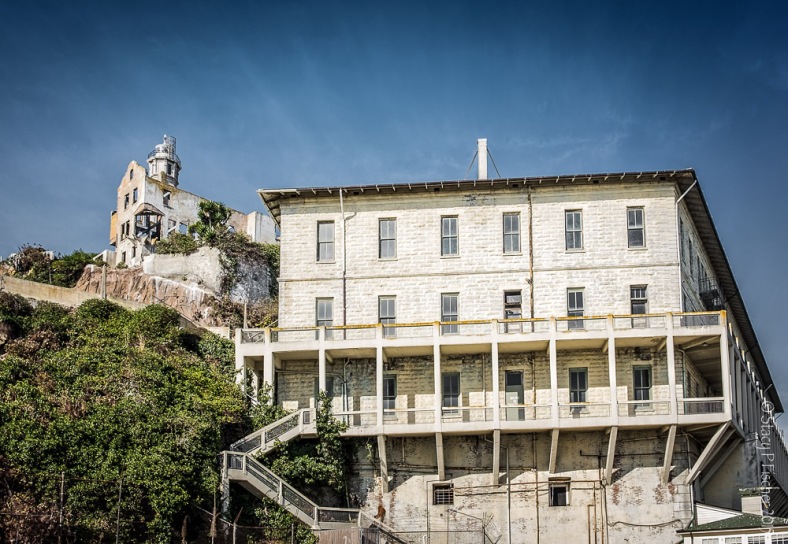
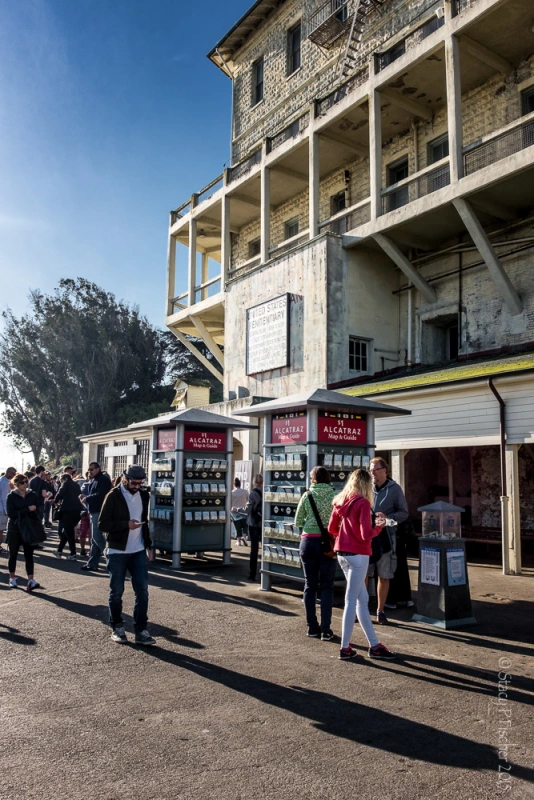
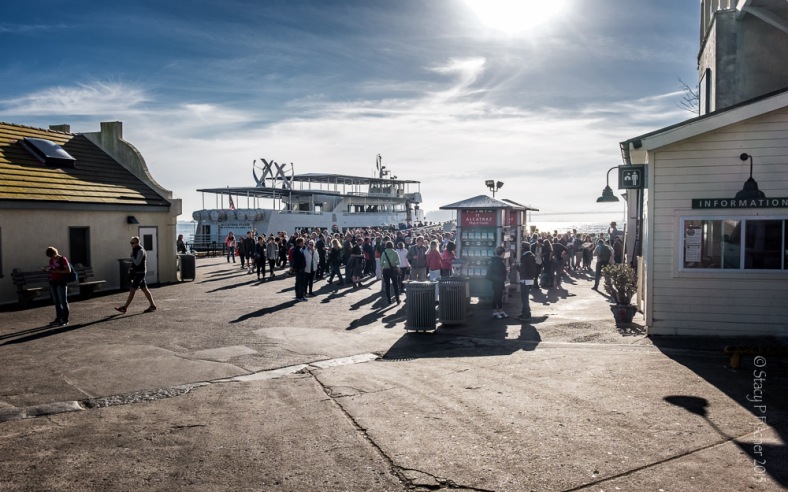
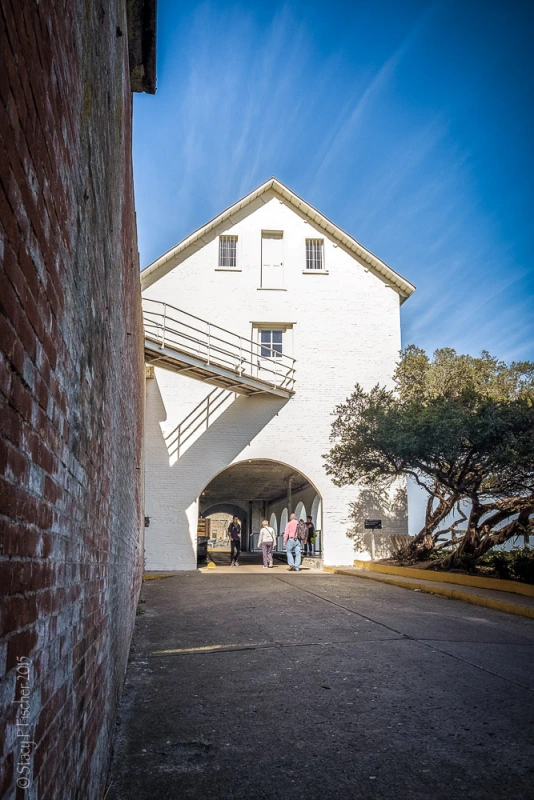
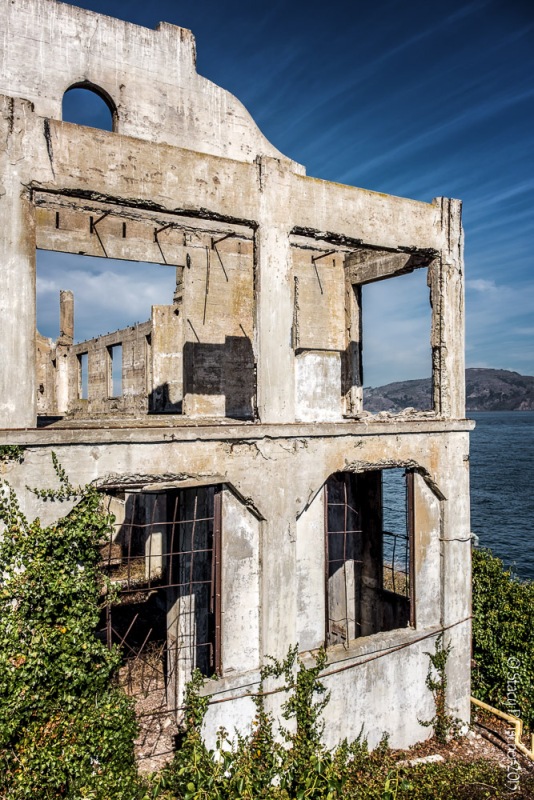
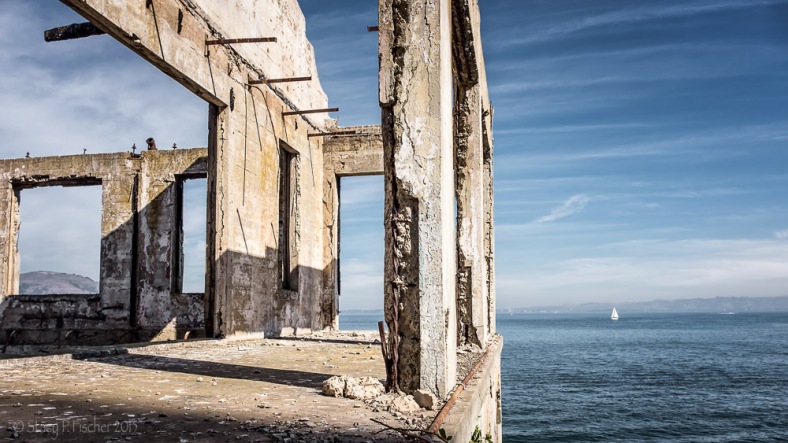
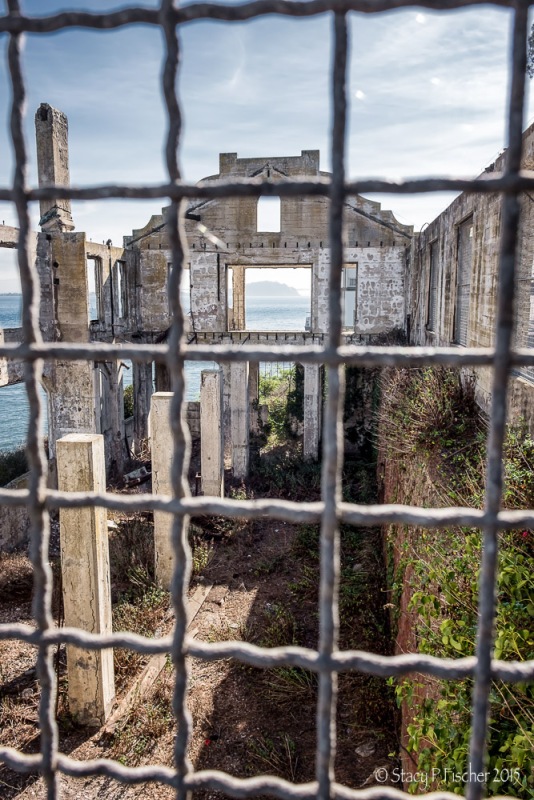
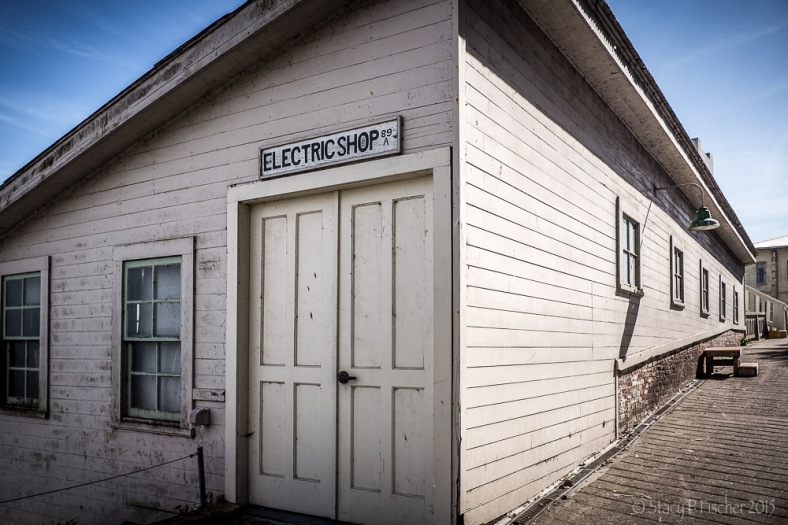
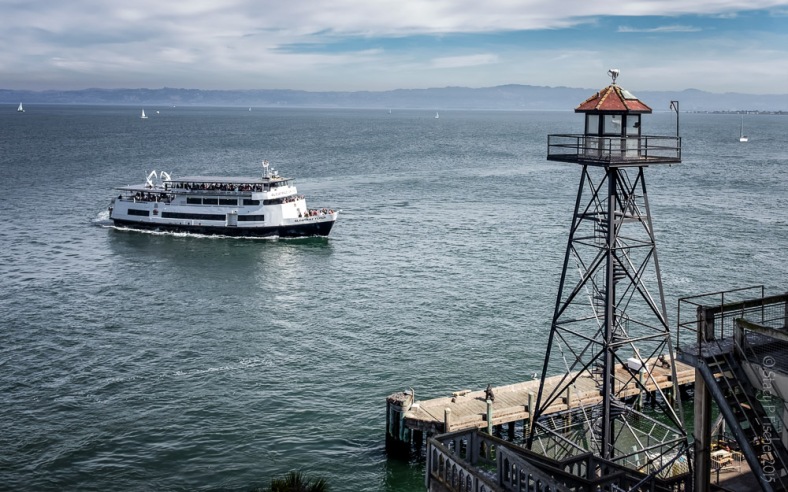
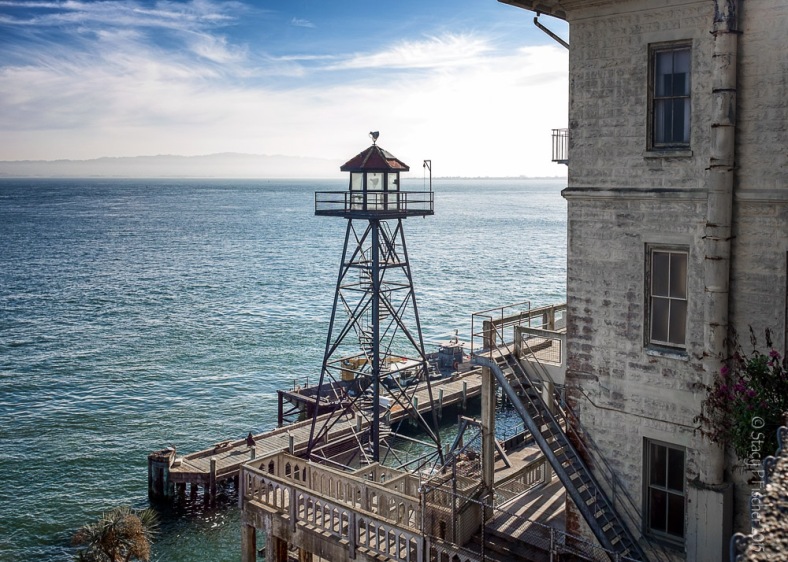
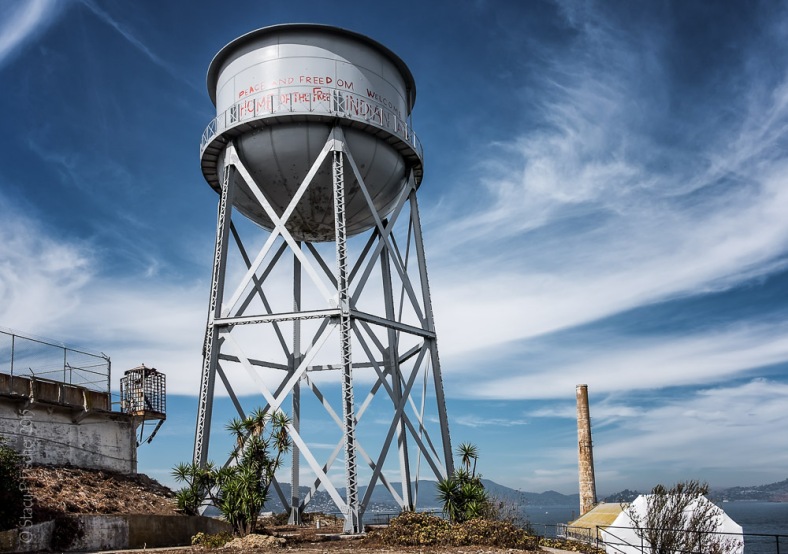
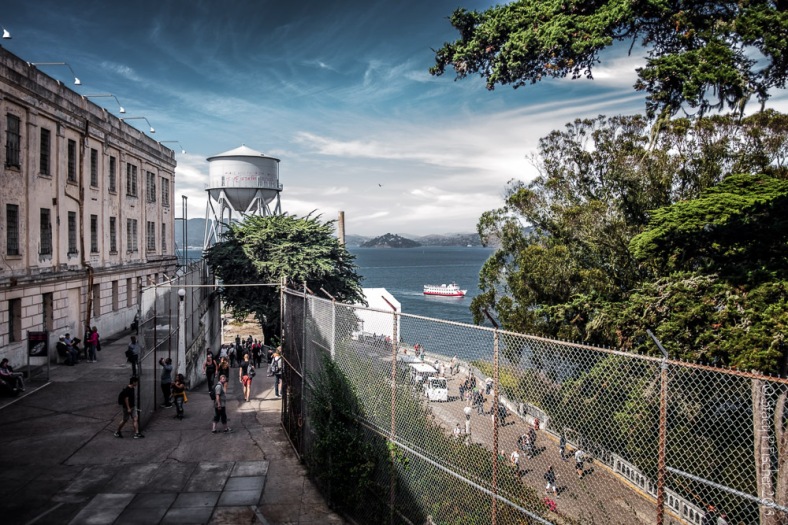
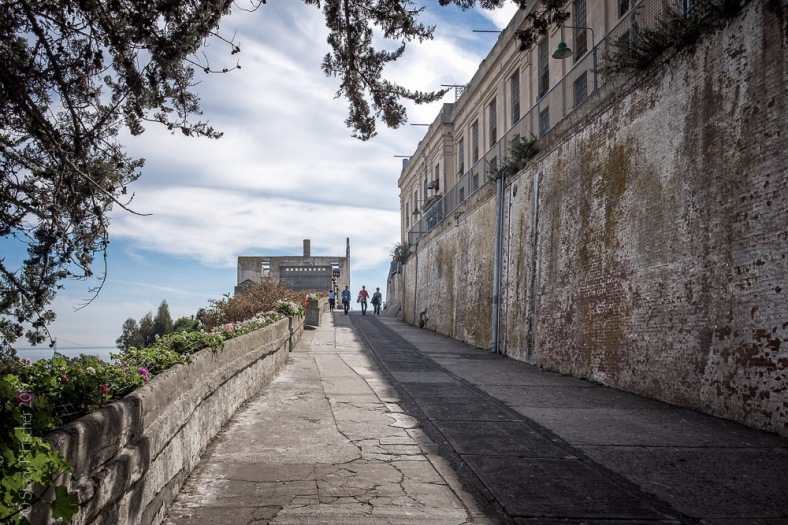
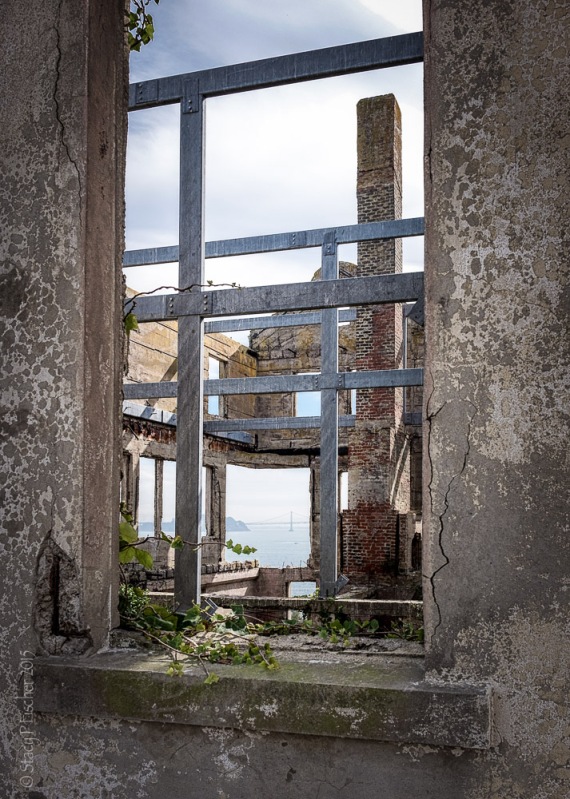
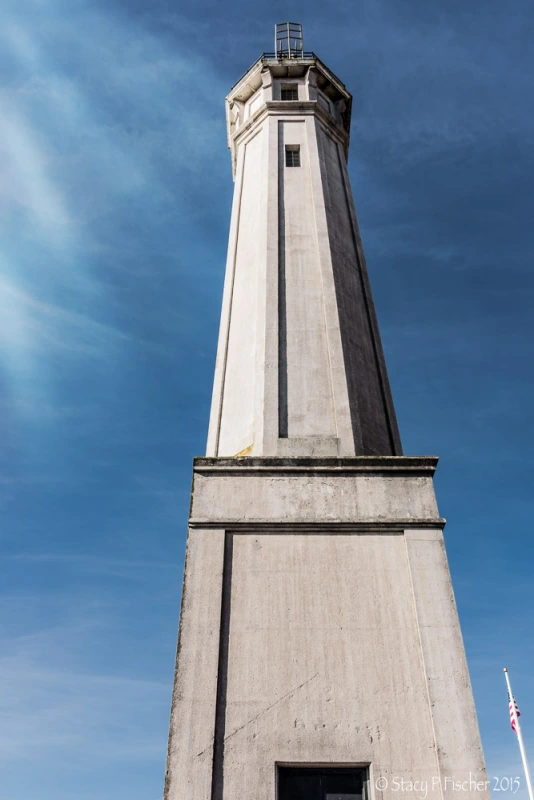
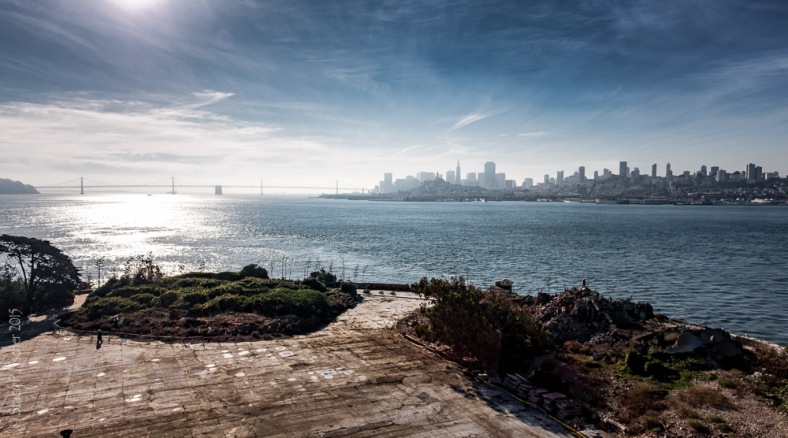
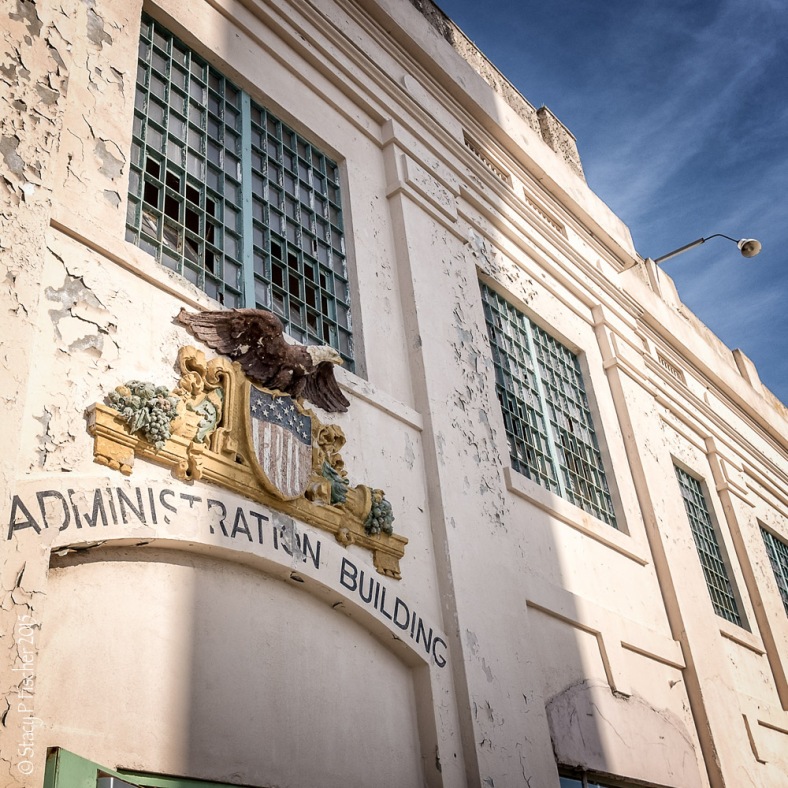
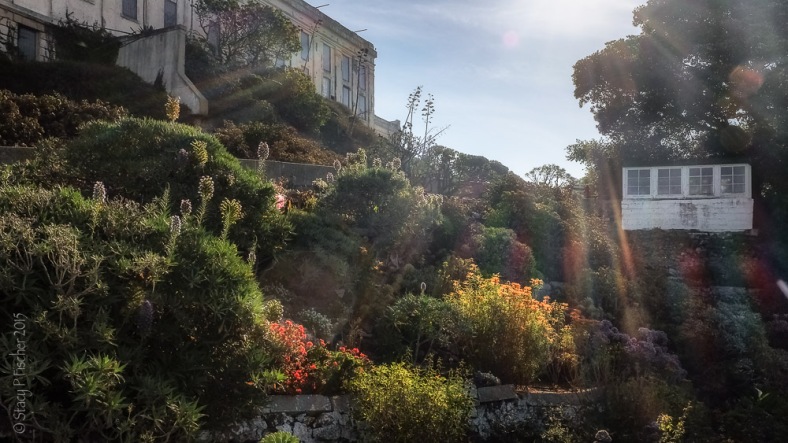
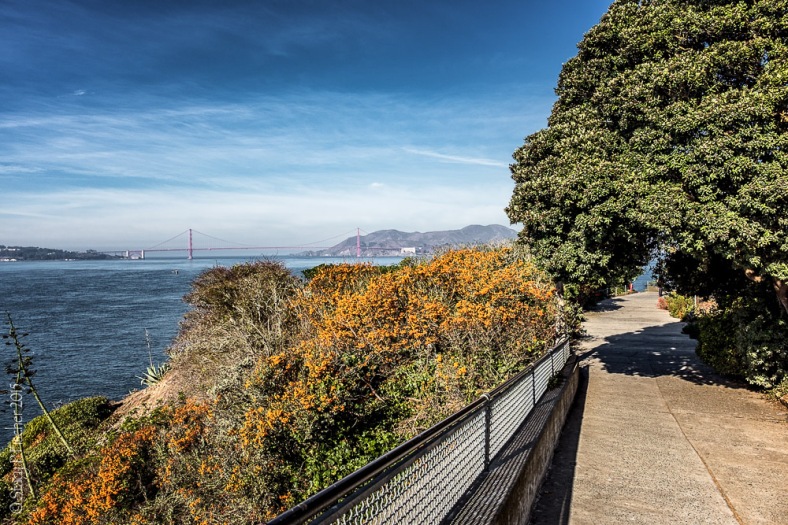
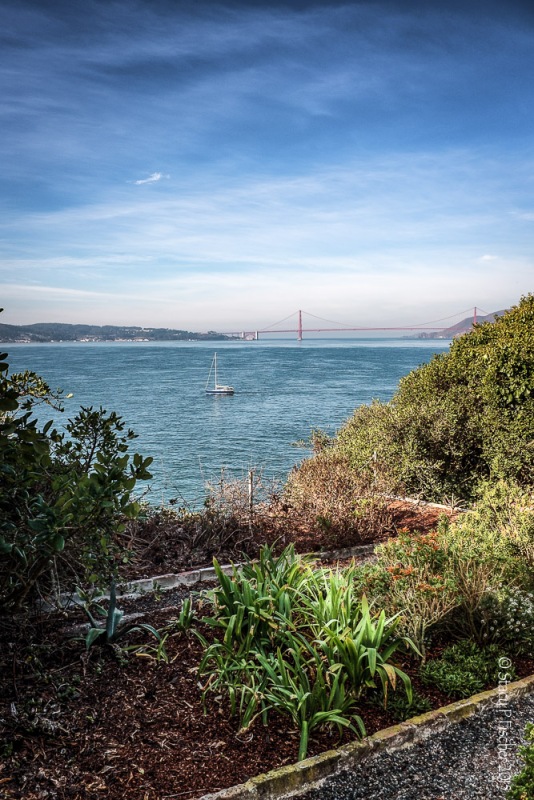
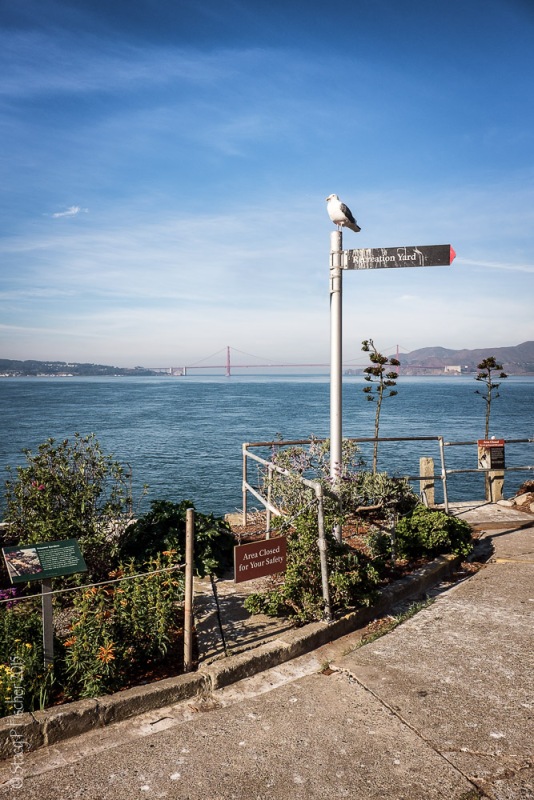
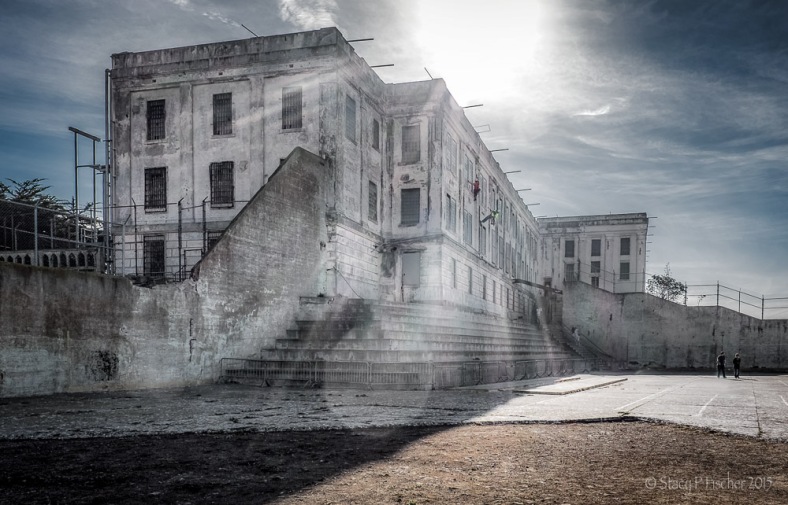
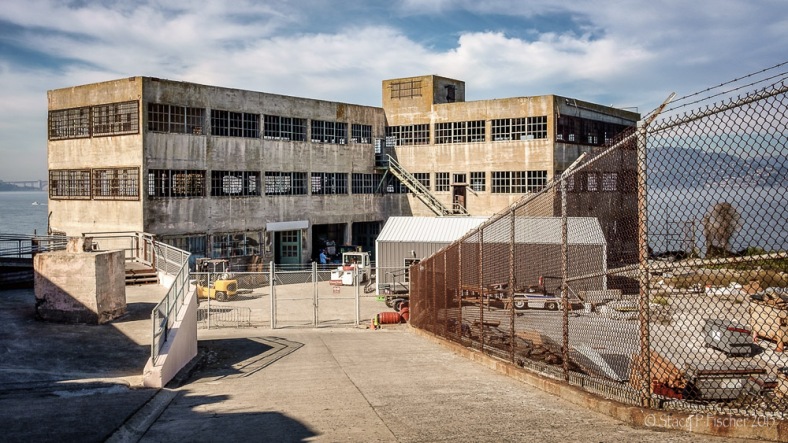
Looks like I missed this whole series of posts Stacy. These images are superb 🙂
LikeLike
Thanks, Joe! I had a blast with my 100T that day! And don’t you remember the texts you, me, and Emilio traded while I was roaming the streets of San Francisco? Just let me say it was Fleet Week and Emilio was up to his usual shenanigans 🙂
LikeLiked by 1 person
I do remember the comment about Fleet Week, LOL 🙂 Emilio is a piece or work.
LikeLike
😂 That he is!
LikeLiked by 1 person
Stunning views! I don’t know if I should be saying this, but I think I’d have liked being a prisoner there…those views and fresh air and sunshine would keep me very happy, but then I’m an island girl and love to meditate on Nature. Remember the Birdman of Alcatraz, a true story? Today Alcatraz would be worth a fortune if it were up for sale to property developers. I’d live there! Those guys hanging off the wall were either cleaning windows or doing a bit of abseiling!! LOL Excellent post, Stacy!
LikeLike
Hmmm, perhaps better if you were a resident as opposed to an inmate 😉 As for the Birdman of Alcatraz, Robert Stroud was a prisoner at Alcatraz but he never kept any birds there. Another Hollywood story debunked 😉 Thanks, Janina.
LikeLike
LOL…yeah, being an inmate wouldn’t be too great!
I hadn’t realised the Birdman story was fiction, but am aware of creative licence. Shame, it was a good story about maintaining connections with Nature even in dire circumstances such as being a prisoner.
LikeLike
He did have birds at the prison he came from (I think Leavenworth, but I can’t swear to it), so there’s truth in that he did have birds – just not at Alcatraz.
LikeLiked by 1 person
Aahh, okay! Much like The Sound of Music…that’s a piece of fiction too, to some extent, according to an in-depth doco I saw recently. Oh, well…I like fiction! 😉
LikeLiked by 1 person
Me too 🙂
LikeLike
Thank you for this lovely combination of photographs and history!
LikeLike
Thank you, Christel! I’m so glad you enjoyed it!
LikeLike
I am enjoying this series on Alcatraz. I have never been so I am enjoying the tour and information!
LikeLike
I’m happy to hear that, Nancy 🙂 Though I must admit that writing the posts is taking longer than I thought it would! I’ve got the photos together and in the post for the next round – I just have to add text!
LikeLiked by 1 person
What an amazing tour. It’s so different from how I imagined it.
LikeLike
I know, for me too, Sylvia! So glad you came along 🙂
LikeLiked by 1 person
A fascinating place and great shots Stacy. I suppose it seemed like a good idea at the time to put the prison there but you can imagine developers drooling over the rock now.
LikeLike
Thanks, Patti. And I don’t think developers will ever get their hands on it! Too popular a place filled with too much history, thank goodness 🙂
LikeLike
Hey, great tour! I’m pumped for more!
LikeLike
Working on it 😉 Thanks, Lisa!
LikeLiked by 1 person
Really interesting – it seems as if it was almost self sufficient – a little secular version of Vatican City.
LikeLike
Actually, while Alcatraz did have its own power plant to generate electricity, everything else had to be brought in by boat, including food and water, which made it a very expensive prison to maintain. The cost, coupled with a number of other factors, including reduced prison budgets stemming from the public’s changing perspective on crime and punishment in post-WWII prosperity, were what finally led to Alcatraz’s closure.
Apologies for the mini history lesson, Pauline. I’m just loving learning about this place 🙂
LikeLike
Something I’d like to know is how many prisoners were housed there? And why all the fires destroying those buildings?
LikeLike
Janina, I have a new post scheduled for the morning of December 16th that addresses the various numbers regarding the inmate population, but it had 336 cells. As for the fires, they occurred during the Indian occupation of the island. It was never determined how the fires started.
LikeLike
OK, will have a look at your post, Stacy!
Fires…yes, I guess it would have been a form of protest.
LikeLike
Whether or not they did set the fires, they did paint a message on the water tower and there are remnants of graffiti in the dungeon cells in Alcatraz. (You’ll read about these cells in the post too 😀)
LikeLiked by 1 person
It’s 4.26pm 16th dec right now, where I am. What is it where you are?
LikeLike
It’s 12:39am, Dec 16th. And it’s definitely time to go to bed! 💤
LikeLiked by 1 person
OK…I’ll let you do that!!! So, that means…ummm…
LikeLike
Wonderful photographs! It is a thoroughly interesting place and I am sure you were constantly clicking away.
LikeLike
Thanks, Laura, and yes, I was! Still a few more posts in the series to come 🙂
LikeLiked by 1 person
Wonderful post and pics… but so much yearn for me…
Ciao ciao
Max
LikeLike
Thanks, Max! Some day I hope you get to go back. 🙂
LikeLiked by 1 person
Fantastic shots – I can’t believe the eagle is still relatively intact over the door of the administration building! 🙂
LikeLike
Thanks, Joanne! I don’t know if any type of refurbishment was done to it, like on the water tower, which was so rusted. Interesting fact that in repainting the tower, extreme care was taken to document the placement of the original painted message. After repainting, it was once again hand painted with paint brushes (at then time of the original, there was apparently no such thing as spray paint!). So upkeep and attention to detail really does keep Alcatraz “alive.” 😃
LikeLiked by 1 person
That seems almost bizarre but it is part of Alcatraz’s history.
LikeLike
Yup, bizarre, but very much part of the Alcatraz story that I’m certain most people don’t know about. I certainly didn’t.
LikeLiked by 1 person
It was news to me and I’ve been there, lol! 🙂
LikeLiked by 1 person
Great post, so interesting and your photos are stunning
LikeLike
I appreciate that, Raewyn! I don’t know how those who write travel blogs do it. While I gathered quite a bit of information on the tour, I really did do a lot of googling to fill in missing pieces. Very time intensive, and hence the reason for such a long period between the Alcatraz posts. In the positive side, I’m loving learning more about this fascinating place!
LikeLike
So nice to see your photos, Stacy. We were there in a rainy day, so most photos were gray 😉
LikeLike
I was so fortunate the weather was perfect and the skies were filled with such amazing clouds! Really added a lot to the experience and the photos. Thanks, Helen!
LikeLike
Thanks for the tour – very nice.
LikeLike
You’re very welcome, Robert! Thanks for walking along 🙂
LikeLiked by 1 person
Very interesting post and great pictures, Stacy!
LikeLike
Thanks so much, Sue! There was a lot of text with this post, but I felt I couldn’t simply post the photos without any explanation. Thanks for reading 🙂
LikeLiked by 1 person
Wow, what a great place. Thanks for the tour.
LikeLike
You’re very welcome, Mary 🙂 It’s been fun reliving the experience as I put together the posts! And it now occurs to me that I haven’t seen your posts in my reader. Hmmm, I must check into that and catch up with you!
LikeLike
You chose great angles for your shots. Well composed and interesting. I remember when we went a few years ago. I thought..ok we’ll go…it’s a touristy thing to do, but I’ll go along since the hubby wanted to go. It ended up being one of my favorite spots in San Francisco.
LikeLike
Thanks, Lisa! It was definitely the highlight of my trip there – my family thought I was a bit crazy when they heard my plan to go twice in the same day (first day tour plus the night tour), but the ability to experience it at different times of the day was magical! Even though I took a lot of shots, there are definitely quite a few I missed, either that didn’t turn out the way I had hoped or that I just didn’t get to. I’d love to go back, knowing what I know now. I’ve actually begun a list of what I would photograph if I did 🙂
LikeLiked by 1 person
I’ve never gone at night. That will go on the list if I ever make it back out there.
LikeLike
It’s a must!! 🙂
LikeLiked by 1 person
Stacy this is just amazing! I love everything about this entire set …and Im a History nut so this is perfect for me!
LikeLike
Thanks so much, West! A history nut, huh? That’s such a fun thing to learn about you 🙂 So glad you’re enjoying it!
LikeLiked by 1 person
Beautiful photos Stacy… god I remember that walk to the top… luckily the guy felt sorry for me and let me on the buggy… bless him. I did walk back down though… You have really captured the mood of the Rock…. don’t know how you found it but that boat ride can be a bit rough at times…
LikeLike
LOL, Bren! I, too, caught that same buggy down the hill to meet up with a park ranger who had promised to take me through the hospital on her break 🙂 And then we proceeded to walk right back up to the cellhouse 😜 As for the boat ride, it actually was pretty calm – enough for me to get decent pictures on the way over! Thanks for going on the walk with me 😀
LikeLike